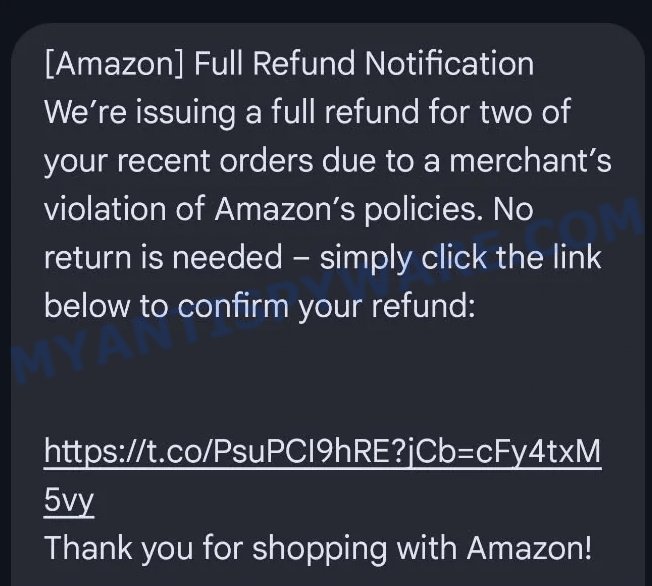Have you come across a text message that says “[Amazon] Full Refund Notification” and tells you that you’re due a refund for two orders? The message shows a link that looks like it goes to an Amazon page.

Question: Is what you received a normal, legal refund notice from Amazon, or is it something else?
Investigation Findings: This message is a fake. The link in the text does not go to Amazon’s real website. Instead, it takes you to a fake site that tries to get your login details and may steal your data.
Answer: The Amazon Refund Text is a fraudulent scam message pretending to be from Amazon. 💡 To protect yourself from scams like this, never click on links in unexpected messages and always check with Amazon directly if you think something is wrong. Additionally, do not share your personal or login information with any site you are not sure is safe.
🚨 Is the Amazon Refund Text Scam Legit?
Fake Amazon refund notifications are being sent via text message, tricking recipients into clicking malicious links that steal personal data. These scam messages mimic legitimate Amazon communications, but their true purpose is to harvest login credentials and other sensitive information.
A typical “Amazon Refund” scam text message may look like this:
[Amazon] Full Refund Notification
We’re issuing a full refund for two of your recent orders due to a merchant’s violation of Amazon’s policies. No return is needed – simply click the link below to confirm your refund:
https://t.co/xxxxxxx?jCb=xxx
Thank you for shopping with Amazon!
Key Red Flags:
- 🌐 Suspicious Sender Information: The texts appear to come from “Amazon”, yet often originate from unfamiliar or short-coded numbers rather than official Amazon channels.
- 🔗 Malicious Links Disguised as Refund Confirmations: The notification promises a full refund with no return required and instructs you to click a link. However, this link typically leads to a fraudulent website designed to look like Amazon’s login page.
- ⚠️ Urgent and Unsolicited Refund Claims: The messages often claim refunds due to policy violations or merchant issues, creating a sense of urgency that pressures recipients to act quickly without verifying the claim.
- 💡 Poor Grammar and Generic Content: While some scam texts have become more polished, many still contain generic greetings and minor errors that signal they are not from an official source.
- 🔒 Absence of Official Amazon Communication: Amazon typically confirms refunds through your account on its official website or app, not via unsolicited text messages with clickable links.
In summary, the Amazon refund text scam is a deceptive ploy designed to steal data by mimicking authentic refund notifications. It is crucial to avoid clicking on any links contained in such messages and to verify any refund or transaction details directly on the official Amazon website. If you receive an unexpected refund notification, contact Amazon Customer Service immediately to ensure your account’s security.
🕵️♂️ How the Fake Amazon Refund Scam Operates
Scammers behind this Amazon refund scam start by sending fraudulent text messages that appear to be official notifications from Amazon. These messages typically announce a full refund for recent orders due to a merchant’s policy violation. The texts mimic authentic Amazon communication by using familiar logos and urgent language, such as “Full Refund Notification” and phrases like “No return is needed”.
When users tap the included link, they are redirected to a malicious website that looks nearly identical to the official Amazon login page. Instead of a secure and recognizable URL, the link (e.g., https://t.co/xxxxxx?jCb=xxx) actually routes to a sketchy domain like hxxps://248618.cc/?t=xxx. This deceptive design tricks consumers into entering their account details, ultimately allowing scammers to steal sensitive data.
The scam relies on the victim’s trust in Amazon’s brand. By fabricating a sense of urgency and legitimacy—claiming, for example, that a refund is being processed automatically—the fraudsters pressure the recipient into clicking without verifying authenticity. The tactic is further supported by the use of language that suggests immediate action is required, thereby exploiting individuals who might be distracted or anxious about their orders.
In summary, the fake Amazon refund scam leverages deceptive text messages with urgent refund notifications, fraudulent links, and counterfeit login pages to steal personal and financial information. Consumers need to be cautious, verify unexpected messages via official Amazon channels, and avoid clicking on suspicious links to protect themselves from such scams.
Summary Table
| Name | Amazon Refund Text Scam |
| Type | Phishing via SMS |
| Method | Fake refund notification with a link to a malicious website |
| Platform | Text message (SMS) |
| Link Redirect | hxxps://248618.cc/?t=xxx |
| Goal | To steal login credentials and personal data |
📱 What to Do When You Receive the “Amazon Refund” Scam Text Message
We advise everyone who receives this message to follow these simple steps to protect themselves from potential scams:
- ❌ Do not believe this message.
- 🔒 NEVER share your personal information or passwords via text.
- 🚫 Do not click on any links in suspicious messages.
- 🔍 Verify any phone numbers or links by checking the official website or contacting customer support directly.
- 📣 Report the scam text to your carrier by forwarding it to 7726 (SPAM).
If you accidentally clicked on a link in the “Amazon Refund” text, suspect that your device may be compromised, or just want to check for threats, use one of the free malware removal tools. Additionally, consider taking the following steps:
- 🔑 Change your passwords: Update passwords for your email, banking, and other important accounts.
- 🛡️ Enable two-factor authentication (2FA): Add an extra layer of security to your accounts.
- 📞 Contact your financial institutions: Inform them of any suspicious activity.
- 🔄 Monitor your accounts: Keep an eye on your bank statements and credit reports for any unusual activity.
🔍 How to Spot a Scam Text Message
Scam messages often share common characteristics. By learning these signs, you can detect and avoid text scams:

💡 Here Are Some Ways to Recognize a Scam Text
- 📞 Unknown or Suspicious Numbers: Scam texts often come from unknown or very generic numbers, not official customer service numbers.
- 🔠 Misspelled Brand Names: Look carefully for any misspellings in the brand or company names, as scammers often try to mimic real companies.
- 👋 Generic Greetings: Messages starting with vague greetings like “Dear Customer” may not be from trusted companies.
- 🔗 Suspicious Links: Do not click on any links in suspicious messages. Instead, visit the company’s official website directly.
- ⏰ Sense of Urgency: Messages that demand immediate action or else a penalty will apply are often scams.
- 📝 Spelling and Grammar Errors: Scam texts may contain spelling mistakes or grammatical errors. Legitimate companies usually ensure proper language use.
- 🔒 Requests for Sensitive Information: Trustworthy organizations do not ask for passwords, credit card numbers, or Social Security numbers through text.
✅ Conclusion
Fake Amazon Refund notifications are a clever scam designed to steal your personal data and compromise your Amazon account security. These scam text messages typically claim that you’re due a full refund for recent orders—citing a so-called merchant violation of Amazon’s policies—and instruct you to click on a link to “confirm” the refund. However, the provided link doesn’t lead to the legitimate Amazon website. Instead, it takes you to a fraudulent site that mimics an authentic Amazon login page in order to harvest your login credentials and other sensitive information.
Scammers use urgent language and official-sounding updates to prompt hasty action without time for proper scrutiny. They even title the messages with “[Amazon]” to appear trustworthy. Do not be fooled by the superficial “refund” promise—there is no violation or refund pending from Amazon.
Bottom Line:
Avoid clicking on any links contained in unexpected refund notifications. Always verify any refund or account update directly through your official Amazon account. If something seems too good to be true or uses high-pressure tactics, it’s most likely a scam. Stay alert, keep your data safe, and report any suspicious messages to Amazon immediately.


















I didn’t type in my Amazon password though this scammer now has my email address. What should I do?